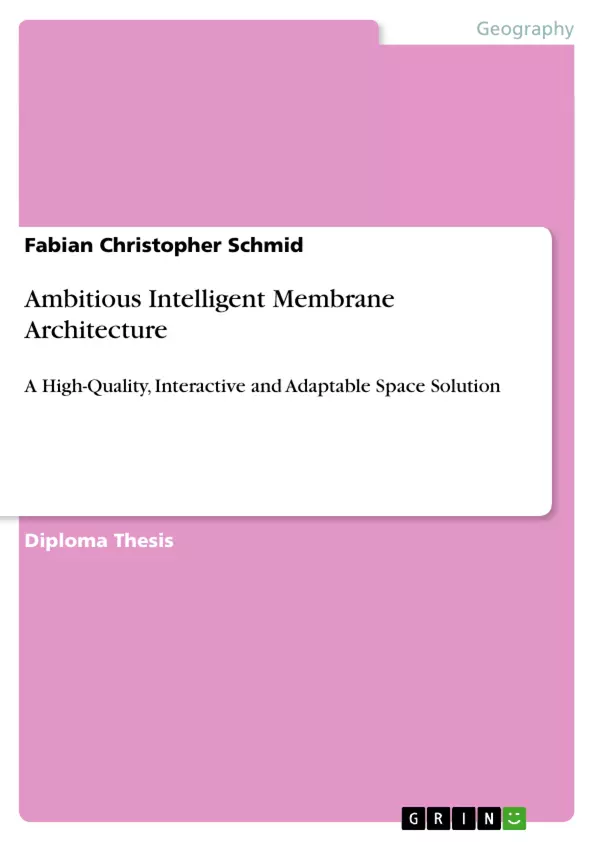
Ambitious Intelligent Membrane Architecture
Diplomarbeit, 2009
91 Seiten, Note: 1,0
Leseprobe
Inhaltsverzeichnis (Table of Contents)
- Preface
- VISION, MISSION, AND GUIDELINES
- Innovation and Improvement
- Communication and Education
- Experience, Education, and Reflection
- Adjustment and Flexibility of Daily Habits
- Summary
- DEFINITION, REASON, QUALITY AND MAIN FOCUS
- Textile and Membrane Architecture
- Building Typologies, their Construction System and Architectural Elements
- Technological Reasons
- Environmental Reasons
- Aesthetic Reasons
- Social and Economical Reasons
- Thematic Consolidation and Methodical Approach
- THE QUALITATIVE, INTERACTIVE AND ADAPTIVE SPACE
- Terminology and Dimensions
- Functionality
- Geometric Programmable Structure and Supply SystemTM
- Adaptive Functional Surface
- Sensible Intelligent Space
- FORM FINDING AND REVISION
- Parametric Computer Model
- Parameters and the Influence of Contextual Conditions
- Physical Models
- Mock-up
- SCENARIOS
- Singular Unit
- Singular Spatial Cells
- Connected Cell Structures
- Networks
- DETAILED TECHNOLOGICAL AND SOCIAL STUDIES
- Art Installation in Tate Modern [London] and/or the MoMA [New York]
- Extension of the Polar Station 'Neumeyer III' and of the International Space Station [IRS]
- LIST OF ABBREVIATIONS
- BIBLIOGRAPHY
- LIST OF FIGURES
- LIST OF ANIMATIONS
Zielsetzung und Themenschwerpunkte (Objectives and Key Themes)
The thesis aims to explore the potential of textile and membrane architecture as a future-oriented solution for creating adaptable and interactive spaces. The work focuses on analyzing the technological, ecological, aesthetic, and social aspects of this architectural approach, highlighting the importance of integrating innovation, communication, and adaptability into the built environment. Key themes explored in the thesis include:- The development of intelligent membranes and their potential for architectural applications
- The creation of high-quality, interactive, and adaptable spaces that respond to user needs and environmental conditions
- The integration of technological advancements in communication and computer technology to enhance the user experience
- The exploration of the role of textile architecture in addressing global challenges such as climate change and urbanization
- The importance of interdisciplinary collaboration and knowledge sharing in advancing the field of intelligent membrane architecture
Zusammenfassung der Kapitel (Chapter Summaries)
The first chapter explores the vision and mission of the thesis, highlighting the need for innovative and adaptable architecture in response to global challenges. The chapter discusses the importance of communication and education in integrating new technologies and emphasizes the role of architecture in shaping a sustainable future.
Chapter two defines and examines the key characteristics of textile and membrane architecture, highlighting its historical development and potential for contemporary use. It further analyzes the technological, environmental, aesthetic, social, and economic reasons for exploring this architectural approach.
Chapter three delves into the concept of a qualitative, interactive, and adaptable space, outlining the key elements of the Geometric Programmable Structure and Supply SystemTM (GP3S), Adaptive Functional SurfaceTM (AFS), and Sensible Intelligent Space (SIS).
Chapter four focuses on the form-finding and revision process, detailing the use of parametric computer models and physical models for generating and refining the adaptable geometry. It further examines the influence of contextual conditions, including solar altitude, daylight level, temperature differences, and wind speeds, on the structure's response and adaptability.
Chapter five presents various scenarios for the application of intelligent membrane architecture, exploring its potential for creating singular units, spatial cells, connected cell structures, and networks. The chapter highlights the adaptability of the system for a wide range of uses, including furniture, shelters, temporary buildings, exhibition spaces, residential structures, and urban infrastructure.
Chapter six presents detailed technological and social studies, showcasing two potential projects: an art installation in the Tate Modern or MoMA, which explores the interaction of users with intelligent spaces; and the extension of the Neumeyer III polar station or the International Space Station, highlighting the system's capabilities in extreme environments.
Schlüsselwörter (Keywords)
Textile architecture, intelligent membranes, adaptive spaces, interactive architecture, sustainable design, communication technology, urban design, climate change, globalization, interdisciplinary collaboration.Details
- Titel
- Ambitious Intelligent Membrane Architecture
- Untertitel
- A High-Quality, Interactive and Adaptable Space Solution
- Hochschule
- Universität Stuttgart (Institute of Lightweight Structures and Conceptual Design / Massachusetts Institute of Technology, Department of Architectural Design)
- Veranstaltung
- Architecture and Urban Planning
- Note
- 1,0
- Autor
- Fabian Christopher Schmid (Autor:in)
- Erscheinungsjahr
- 2009
- Seiten
- 91
- Katalognummer
- V287205
- ISBN (eBook)
- 9783656876199
- ISBN (Buch)
- 9783656876205
- Dateigröße
- 10683 KB
- Sprache
- Englisch
- Schlagworte
- Membrane Architecture Architecture Intelligent Adaptive Smart Home Textile Space
- Produktsicherheit
- GRIN Publishing GmbH
- Preis (Ebook)
- US$ 38,99
- Preis (Book)
- US$ 50,99
- Arbeit zitieren
- Fabian Christopher Schmid (Autor:in), 2009, Ambitious Intelligent Membrane Architecture, München, Page::Imprint:: GRINVerlagOHG, https://www.diplomarbeiten24.de/document/287205
- Autor werden
- Ihre Optionen
- Vertriebskanäle
- Premium Services
- Autorenprofil
- Textarten und Formate
- Services für Verlage, Hochschulen, Unternehmen

- © GRIN Publishing GmbH.
- Alle Inhalte urheberrechtlich geschützt. Kopieren und verbreiten untersagt.
- info@grin.com
- AGB
- Open Publishing
Der GRIN Verlag hat sich seit 1998 auf die Veröffentlichung akademischer eBooks und Bücher spezialisiert. Der GRIN Verlag steht damit als erstes Unternehmen für User Generated Quality Content. Die Verlagsseiten GRIN.com, Hausarbeiten.de und Diplomarbeiten24 bieten für Hochschullehrer, Absolventen und Studenten die ideale Plattform, wissenschaftliche Texte wie Hausarbeiten, Referate, Bachelorarbeiten, Masterarbeiten, Diplomarbeiten, Dissertationen und wissenschaftliche Aufsätze einem breiten Publikum zu präsentieren.
Kostenfreie Veröffentlichung: Hausarbeit, Bachelorarbeit, Diplomarbeit, Dissertation, Masterarbeit, Interpretation oder Referat jetzt veröffentlichen!
- GRIN Verlag GmbH
-
- Nymphenburger Str. 86
- 80636
- Munich, Deutschland
- +49 89-550559-0
- +49 89-550559-10
- info@grin.com
-









